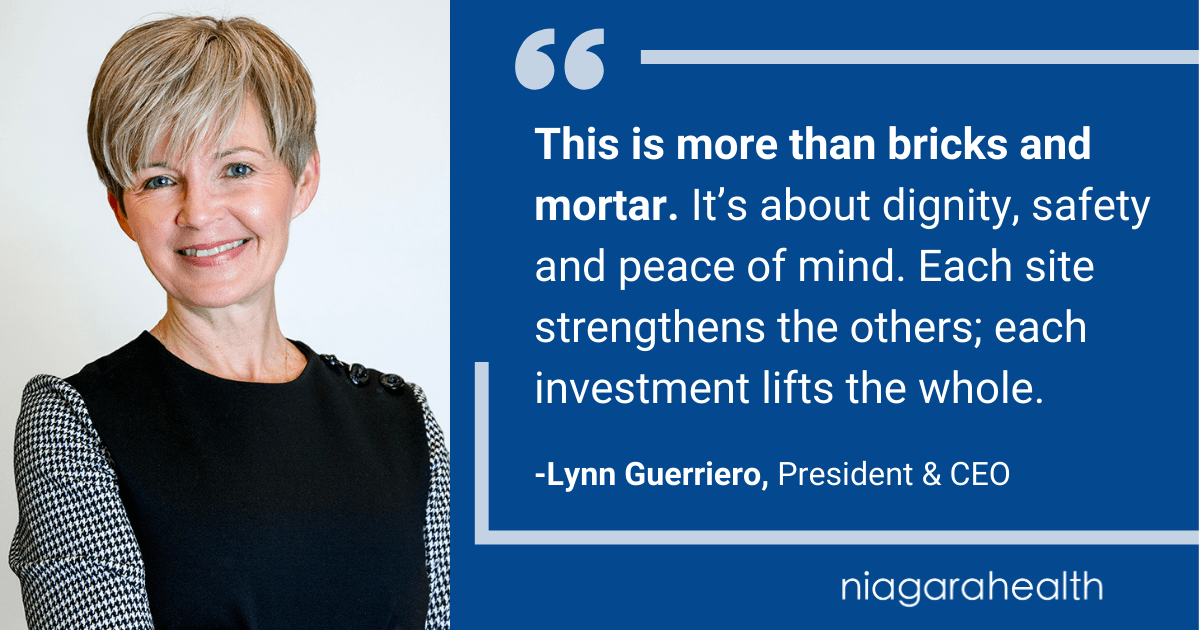This is an opinion column written by President and CEO Lynn Guerriero and Harpreet Bassi, Executive Vice-President of Strategy, Research and Redevelopment, published in the St. Catharines Standard, Niagara Falls Review and Welland Tribune.

Every family in Niagara knows how important it is to get the right care, close to home, when they need it most. The future of that care — faster, stronger, and more connected — depends on decisions many municipal councils will make in the coming weeks.
More than a decade ago, municipalities across Niagara agreed in principle to support a new, modern hospital system with local share contributions. At the time, it felt like a far-off commitment. Now, the future has arrived.
The decision is bigger than any single budget line. It will decide whether Niagara builds the hospital system our communities deserve, or whether we risk slowing progress, delaying construction and sending a signal to the province that we cannot deliver on our own commitment.
The South Niagara Hospital is at the heart of this transformation. Together with the Marotta Family Hospital and a redeveloped Welland Hospital, it will form a connected three-site system designed to cut wait times, improve patient flow and ensure people get the right care in the right place. Patients won’t have to worry about going through the “wrong door.” No matter where they enter, they’ll be guided quickly to the care they need.
This is more than bricks and mortar. It’s about dignity, safety and peace of mind. Each site strengthens the others; each investment lifts the whole.
Ontario covers most hospital construction costs, but communities have long been expected to contribute about 10 per cent — the “local share.” This isn’t simply an accounting formula. It is a partnership model that ensures local voices shape their healthcare system and signals to the province that communities are committed. Without that signal, projects risk delay and momentum can stall.
The plans for Welland show why these investments matter. Work is underway with the province to redevelop the Welland site, starting with renovations that will increase complex continuing care beds and relocate the residential addictions treatment centre. These improvements will strengthen services for all Niagara residents and relieve pressure across the entire system. The same is true for each of the three hospitals — what happens at one benefits all.
We know councils face tough choices. Municipal budgets are stretched, and every dollar is spoken for. But healthcare is not just another service. It is the foundation that supports residents, businesses and entire communities. Strong hospitals with modern infrastructure attract doctors and other health professionals. They help businesses grow and families thrive. They give communities confidence. They make Niagara a place that is moving forward, not standing still.
The opposite is also true. If councils falter now, the consequences are real. The burden shifts back to hospital budgets, meaning less money for services, equipment and programs — the very things people count on when they walk through our doors. Worse still, hesitation sends a message that Niagara is divided or uncertain, when what we need most is to demonstrate unity and resolve.
This is a once-in-a-generation opportunity to deliver the healthcare system Niagara has been working toward for more than a decade. Councils said yes in principle years ago. The moment has come to make it real.
Local share is more than a funding formula. It is a test of leadership and a statement of values. It is how communities show they believe in care, in confidence, and in progress. For Niagara, it is the path to a stronger hospital system where every resident can count on getting the right care, in the right place, at the right time — today, and for generations to come.

